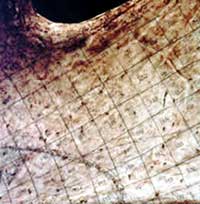Insects’ survival, mating decrease with age in wild, researchers discover

Antler flies (Protopiophila litigata) on a moose antler with an observation grid drawn on the antler surface. <br>Credit: Russell Bonduriansky, U of T
Researchers examine aging in wild insects for first time
A unique insect has given researchers the opportunity to study aging in the wild for the first time.
“Aging – or senescence – has been seen under controlled conditions in the lab, but never before in insects living in their naturally evolved habitat,” says U of T zoology doctoral candidate Russell Bonduriansky. “Our study of antler flies shows these animals do age in the wild.”
Bonduriansky and co-researcher Chad Brassil, both of the evolutionary ecology group at U of T, studied male antler flies to see if there was aging – a term used to denote a deterioration of the body’s vital functions, not chronological time. The two zoologists examined the flies to see if their abilities to survive to the next day and to mate deteriorated with age. The study appears in the Nov. 28 issue of Nature.
“We found that the flies deteriorate over their lives. As they get chronologically older, their chances of dying by the next day increase,” says Bonduriansky. “While their probability of death increased, their probability of mating decreased. A decrease in both survival and reproduction unambiguously demonstrates aging.”
An important feature of the study was the flies’ natural environment, says Brassil. “When you study flies in the lab, they live for a long time because they don’t have any predators or risks. Eventually, however, they do start to deteriorate. Now we have shown that this deterioration also occurs in the wild.”
In Ontario’s Algonquin Park, the researchers studied several hundred antler flies, an insect that breeds exclusively on the discarded antlers of moose and deer. The insects’ relatively small geographical domain enabled the team to mark and track the progress of individual flies throughout their lives. “We had a small number of moose antlers in the field so we knew we were looking at the whole system. We were able to follow the flies throughout their lives – a very rare occurrence in nature where insects characteristically cover a lot of ground,” says Brassil.
To follow the flies, the researchers captured the 2-mm-long flies and hand-painted identification codes on their backs before releasing them. “You can actually see these codes from about 20 or 30 cm away, so it is possible to recognize individuals,” says Bonduriansky. Over the course of 2 ½ months, the researchers followed the marked flies and created biographies for each individual, monitoring their life spans and mating success.
“Evolutionary theorists argue that it is very unlikely that we can ever actually reverse aging or stop it,” says Bonduriansky. “But the unique ecology of the antler fly can at least help us to understand why we age.”
Lanna Crucefix is an assistant news services officer with the department of public affairs.
CONTACT:
Russell Bonduriansky, U of T Zoology, ph: (416) 946-7217; email: russell.bonduriansky@utoronto.ca
Chad Brassil, U of T Zoology, ph: (416) 946-7217; email: brassil@zoo.utoronto.ca
U of T Public Affairs, ph: (416) 978-0260; email: lanna.crucefix@utoronto.ca
Media Contact
More Information:
http://www.newsandevents.utoronto.ca/bin3/021127b.aspAll latest news from the category: Life Sciences and Chemistry
Articles and reports from the Life Sciences and chemistry area deal with applied and basic research into modern biology, chemistry and human medicine.
Valuable information can be found on a range of life sciences fields including bacteriology, biochemistry, bionics, bioinformatics, biophysics, biotechnology, genetics, geobotany, human biology, marine biology, microbiology, molecular biology, cellular biology, zoology, bioinorganic chemistry, microchemistry and environmental chemistry.
Newest articles

High-energy-density aqueous battery based on halogen multi-electron transfer
Traditional non-aqueous lithium-ion batteries have a high energy density, but their safety is compromised due to the flammable organic electrolytes they utilize. Aqueous batteries use water as the solvent for…

First-ever combined heart pump and pig kidney transplant
…gives new hope to patient with terminal illness. Surgeons at NYU Langone Health performed the first-ever combined mechanical heart pump and gene-edited pig kidney transplant surgery in a 54-year-old woman…

Biophysics: Testing how well biomarkers work
LMU researchers have developed a method to determine how reliably target proteins can be labeled using super-resolution fluorescence microscopy. Modern microscopy techniques make it possible to examine the inner workings…





















